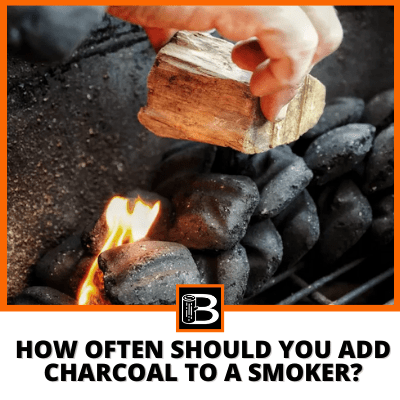
By
James
Updated on
One of the oldest methods of cooking is cooking with charcoal. Over time, this cooking method has been mastered and developed.
Today, chefs have their ways and strategies of using charcoal for cooking, like the minion method.
Technology has made it easy for us to cook with charcoal thanks to Grills and smokers.
Using charcoal for any cooking will give a better flavor than the traditional pan sear or pan-fries as the smoky flavor comes out more and a good crust is formed.

Things you should know
Temperature
To maintain the correct temperature of the smoker, one must keep in mind certain things.
- Always have a thermometer attached with your smoker to control the heat to a certain degree on how you want your meat.
- If your smoker’s temperature drops below 225◦F, add coal and increase your heat if needed.
- Adding a lump of fresh coal to the lit ones will gradually drop the temperature and take a few minutes to get to the right temperature. If you want to smoke your meat at one temperature for the entire cooking process, then pre-lit the charcoal and add it quickly before the temperature drops.
- Not all charcoal is the same. Some produce very high heat, and some moderate amounts of heat. Similarly, some generally burn quicker than others do. Hence, you need to know when to add coal to a smoker by keeping a close eye on the thermometer.
- Add charcoal every couple of hours and adjust the airflow to the right temperature while slowly cooking.
Cooking time
Depending on how well you want to cook your meat, rare, medium-rare, medium, medium-well, well done, it might vary from a minute to 24 hours. Meat, which cooks for a more extended period, like briskets, pulled pork, rib roast, etc., need close monitoring by adding coal and maintaining it to the right temperature. If not, the meat will tend to become dry or over soggy, which will be unpleasant to eat. This is why slow-cooking meat involves high risk with high rewards if monitored the right way.
How to choose charcoal? Pros and Cons
You may think that one bag of charcoal is almost identical to another, or you may buy cheaper charcoal thinking that they are the same. But, there are many different types of charcoal to choose from that could affect the taste of your food. Charcoals like Weber original premium charcoal have high burning heat while some have moderate heat. They also have different flavors depending on the wood in which it is produced. Therefore, it all depends on the consumer’s taste and preferences for charcoal while cooking.
Here are some popular Charcoals with pros and cons.
Briquettes
One of the most common types of charcoal you will find in the store. This charcoal is inexpensive cubes made from sawdust and lumps of hardwood and some addictive that will make the coal hot and burn for a more extended period. This coal needs to be burned entirely until they are cover with white ash as it releases a strong chemical odor that is unpleasant for cooking.
Pros
- They are cheap and inexpensive.
- Very easy to find in local supermarkets.
- Burns for an extended period.
Cons
- It takes a much longer time to light.
- It produces many unwanted ashes.
- It might impart additional flavor to the food.
- To use this charcoal, start the fire and light the coal for at least 30 minutes before cooking to avoid unwanted flavors to the meat.
Hardwood or lump charcoal
There are many different hardwood/lump charcoals, such as the Kamado Joe pound natural hardwood charcoal. These charcoals are made by slowly burning the wood in the absence of oxygen. It gives clean-burning charcoal made from hardwood, which gives a better natural smoky flavor than the Briquettes. It also allows you to be more precise with the smoker’s temperature because of better air control.
Pros
- It can light very quickly.
- It burns in high heat and cleans with no added flavor.
- It responds well with air control.
- It produces less ash than briquettes.
Cons
- It is more expensive than briquettes.
- It has a short burning time,
- The sizes of the coals are uneven and come in all shapes and sizes.
Though expensive, this coal is recommended for use, as it will give a clean and natural flavor to the food. Some of the popular hardwood charcoals are Royal Oaks lump charcoal and Rockwood natural hardwood.
Best hardwoods for smoking meat
Every hardwood differs in taste and is packed with a unique, intense flavor that is best for smoking meat. Most popular among them are Hickory, Red oak, Mesquite, Apple, Pecan, Cherry, Maple, and Plums.
Always cook on an open surface while dealing with charcoal
Charcoal emits carbon monoxide poisoning, and so it does not recommend cooking inside a home, tent, or RV. Well-ventilated rooms or an even high chimney for the smoke to escape does not eliminate the risk of carbon monoxide danger. Always take it outdoors in your backyards where there is enough room for air to circulate.
Is cooking with charcoal harmful to your health?
Cooking with charcoal has the potentiality of causing cancer. It is problematic for two reasons. Firstly, charcoals and hardwood lumps produce hydrocarbons and tiny particles that pollute the air and aggravate heart and lung problems. Secondly, grilling meat in a smoker can produce polycyclic aromatic hydrocarbon (PAHs) and heterocyclic amines (HCAs).
PHAs are formed when fat from the meat drips and falls to the coal-producing smoke, deposited into food. HCAs are formed when cooking at a hotter temperature or longer cooking process. PAHs and HCAs have a potential threat of causing cancer in the human body.
Studies by the national cancer institute (1999) have revealed that cancers are associated with a high intake of well-done meat, fries, or barbequed items.
Conclusion
Charcoal smokers make everything taste better. However, one should also keep in mind that it has some hazardous effects on your health if you consume smoke regularly.
About The Author

Reviewed by
James
James is a writer who is a self-confessed kitchenware and coffee nerd and a strong advocate of Sundays, good butter, and warm sourdough.
Related Posts
[wp post shortcode here]
